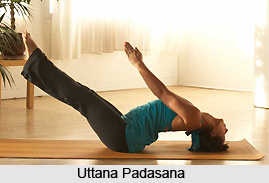 Uttana Padasana, or the raised feet posture, is a cultural yoga asana that tones the muscles of the lower back, thighs and calves, besides helping in a host of digestive ailments.
Uttana Padasana, or the raised feet posture, is a cultural yoga asana that tones the muscles of the lower back, thighs and calves, besides helping in a host of digestive ailments.
Meaning of Uttana Padasana
Uttana, in Sanskrit, means something that is raised, while Pada means feet. Hence, the asana translates to raised feet pose, describing the final position, where the legs are raised at an angle of 60 degrees above the ground.
Practice of Uttana Padasana :
1. Lie down with the back placed on the floor.
2. Fold the hands over the head.
3. Keep heels and toes together.
4. Toes should be pointed upwards.
5. Chin slightly facing the chest.
6. While inhaling, lift both legs to 30 degrees.
7. Hold breath in the posture as much as possible.
8. While exhaling, bring the legs down to the floor without bending the knees.
9. Again inhale and raise the legs to 60 degrees.
10. Retain the breath for a while.
11. While exhaling bring the legs down to the ground.
12. Ardha-Uttanapadasana can be performed in the same manner, by lifting one leg at a time.
Effects of Uttana Padasana:
a) This asana flexes all abdominal muscles, both internally and externally.
b) It takes away the extra weight from the abdominal area.
c) It can correct the disorders relating to the pancreas and can cure constipation as well as other wind troubles.
d) Indigestion and intestinal disorders too can be cured by the regular performance of this asana.
e) This asana also has a great curative and corrective effect on backaches or troubles associated with the waist, buttocks and hip joints.
f) It strengthens the spinal cord, energizes the inner cells and activates the whole nervous system.
g) Reduces the irritability and calms down the mind.
h) This Asana is very beneficial for those suffering from diabetes, constipation, indigestion and nervous weakness.
Precautions in practice of Uttana Padasana
1. High pressure and stretching is felt on the lower abdomen, hence, practice according to capacity.
2. In the beginning take help of hands to raise the legs.
3. While raising do not bend legs at the knees.
4. People suffering from lumbar spondilitis and muscle pull should not practice it.
People with back injuries or having undergone any form of abdominal surgery, should refrain from doing this asana with both legs. They can do it alternately three times with each leg.
Do not practice for more than 5 times at a stretch.




















